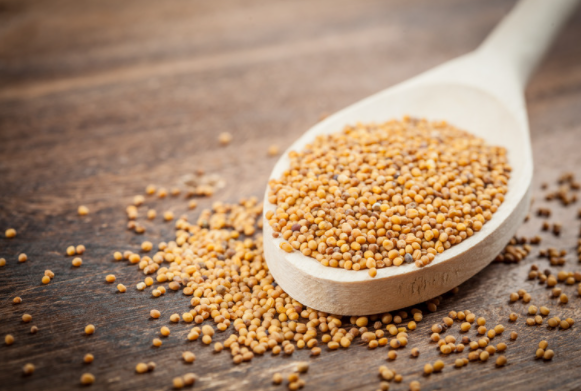
Mustard is a versatile plant that adds distinct flavor to dishes and condiments alike with its flavorful greens and seeds. Like cabbage and broccoli, mustard is a member of the Brassicaceae plant family. Mustard contains a high level of Sulphur, which is responsible for the heat we taste in it, especially in its seeds.
The use of mustard dates back to the ancient Egyptians and Greeks who used the seeds for medicinal and culinary purposes. The Romans followed suit, and would mix ground mustard seeds and unfermented grape juice, called must, to make a spicy paste. This spicy paste was called mustum ardens, or burning must. Mustum ardens was shorted to “must ard.” History tells us that the Romans exported mustard seeds to French Gaul, and the monks in Paris’ Saint Germain des Pres embraced the Roman knowledge of mustard. In the 13th century, farmers in Dijon, France, began producing mustard as we know it.

Mustard is grown for its greens and seeds, which are the main ingredient in the table condiment that most people think of when they hear the word "mustard." The plant's greens, which can be quite strong in flavor, can be eaten in salads when paired with another milder green such as baby spinach or watercress.
Most of us are more familiar with mustard in the form of a potently hot yellow paste that we use in cooking or as a condiment, most famously on hot dogs and hamburgers. There are numerous varieties of condiment mustard available, ranging in intensity from the relatively mild American mustard to the sinus-clearing English variety. German and French mustards have distinct flavors, and even within France, there are several varieties; compare the standard, brown-colored French mustard to the milder, creamier, paler Dijon variety.
Table mustards are made by grinding the mature mustard plant's seeds and combining them with a little liquid, usually vinegar, along with a seasoning of salt and pepper and possibly a little sugar to take the edge off. The finished mustard's strength is determined in part by the type of seeds used. There are black, yellow, and white varieties available. Each has its own strengths and characteristics as there are many different varieties of mustard plants grown. Yellow and white varieties tend to be milder, whereas the black and brown tend to be more spicy and hotter.

Mustard has medicinal uses as well. It has traditionally been made into a poultice and applied to the skin to relieve inflammation and treat bronchial problems such as chest colds. Those who make a medicinal paste typically combine 10% mustard and 90% flour, mixed with water. As with any medicinal application, check with your medical professional before trying this at home.
Mustard is also widely used in agriculture, both as food for livestock and as a crop that can be grown quickly and then plowed back into the soil to enrich and fertilize it in preparation for growing the main crop the following spring.
You don’t need to travel all the way to the regarded mustard capital of the world, Dijon France, to get your fill of mustard. For those in the United States, Middleton, Wisconsin is home to the National Mustard Museum. In 1992, former Wisconsin Assistant Attorney General Barry Levenson left his job to open this museum dedicated to all things mustard which is now one of Wisconsin’s prime tourist attractions.

If you love mustard like we do at RudiGourmand, try the varieties of mustards from around the globe to diversify your options. There are many importers who ship their delicious mustard from France and beyond. And, if you tried it when you were young and didn’t care for it then, why not try it again now to give it another chance?


